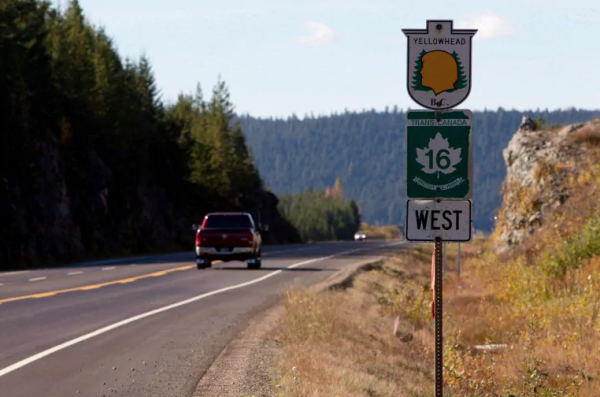
Decline of Greyhound Service Mirrors Rural Canada’s Plight
What does the decline of Greyhound service have to say about the current state of affairs in rural Canada generally. Will Doig of The Guardian files this report.
It’s 10 to midnight when the Winnipeg-bound Greyhound bus swings off of the empty highway and into a dirt lot illuminated by a single street lamp.
Its headlights sweep across the only passenger waiting in this remote lumber town: Mary Reimer, 80, is bundled in a purple parka against the cold.
“Since my husband passed away four years ago, this is how I get to my sister,” she says, before climbing aboard.
It’s the last time she’ll make the journey this way.
Amid cratering passenger figures, Greyhound will discontinue all service in Canada’s western provinces on 31 October. The cuts will eliminate routes that have existed for nearly a century and sever the only transit link for dozens of towns where the British-owned company has endured even as other businesses have trickled away.
Some analysts see it as yet another indicator that rural Canada is not only struggling, but slowly decoupling from the country’s thriving urban cores.
Don Warkentin has witnessed these changes. After 34 years driving Greyhound buses between Winnipeg and the mining city of Flin Flon 11 hours north, he’ll retire next week along with his route.
One of 415 employees phased out by the cuts, he remembers when Greyhound made three runs a day on this stretch, with 24-hour depots at each stop. Now there’s one bus nightly, and most stops are bare-bones roadside pull-offs like this one. “Not as many people are riding these days,” he says, pushing Reimer’s luggage into the undercarriage. “It’s an Uber culture now.”
For those that can’t afford an Uber or the high cost of gas, Greyhound’s decision to write off much of the Canadian frontier is more than an inconvenience.
“Greyhound is a private company, but they were almost public transportation in terms of the service they provided,” says Cathy Sproule, a member of the New Democratic party congress in Saskatchewan.
But Greyhound hasn’t turned a profit on some of those routes in over a decade. Since 2010, ridership has tumbled by 41%, hollowed out by urban migration, discount airlines and rising car ownership. After this month, its buses will no longer travel to points west of Sudbury, Ontario. (A Seattle-Vancouver route, operated by the company’s American counterpart, will continue as usual, and a new company, Rider Express, is poised to take over some routes from Calgary to Winnipeg and Vancouver).
The decline of Greyhound’s Canadian service reflects the story of rural Canada itself.
“We see a confluence of events happening,” says Laura Neidhart, spokeswoman for the advocacy group Canada Without Poverty. “More and more people are leaving rural Canada, and the people who remain are often the ones who are unable to leave.” Since 1950, the rural share of the country’s population has fallen by half.
This is evident in Mafeking, a wisp of a town north of Swan River that’s speckled with boarded-up shops. At the Tempo gas station, the clerk Karina Kryzanowski says she hasn’t ridden the bus since the 1980s, in part because it passes through town in the middle of the night, and passengers have to stand on the road to flag it down – a daunting prospect on a desolate highway in the boreal forest.

Today, over one-third of Canadians live in Toronto, Vancouver, or Montreal, a dramatic shift from when Greyhound Canada launched in British Columbia in 1929.
Back then, mining and farming towns dotted the country’s vast interior.
Too isolated for the private sector to bother with, many of their services – insurance coverage and even liquor stores – were furnished by the government. These “crown corporations” also provided transportation, including taxpayer-funded bus lines.
Some of these lines still operate today. Ontario Northland, for instance, is a bus line financed by the province that links Toronto with tiny outposts 10 hours north-west. A product of Canada’s 20th-century democratic-socialist heyday, the state-run bus lines were founded on the presumption that integrating rural and urban regions benefits both.
That presumption is now being challenged. The starkest example is the Saskatchewan Transportation Company (STC), a 72-year-old state-run bus line that was shuttered last year by the province’s ruling Conservatives.
“It was a total shock,” says Cindy Hanson, an organizer with Stop the Cuts, an advocacy group for public services in the province. “They did it so quickly there was no time to protest.”
Growing up on a farm in Saskatchewan, Hanson remembers her dad receiving machine parts on the STC buses. “They came through twice a day, so it was faster and cheaper than any other shipping method,” she says. When the STC shut down last year, 253 communities were directly affected, according to Hanson.
Afterward, 10 private bus companies stepped in to replace the lost STC routes. Within a year, all but two had walked away, unable to turn a meaningful profit.
“The idea behind the crown corporations is that they’re expected to operate in some areas at a loss,” says Hanson.

At the same time, Canada’s resource-based economy makes this a perilous cycle. “Forestry, mining, oil and gas – you can’t do these things from downtown Toronto,” says Prentice.
But you can do them with far fewer people – insulating city dwellers from realizing the effects of rural decline, says Bill Reimer, professor emeritus at Concordia University.
This gulf perpetuates itself, both culturally and politically. “Until maybe 20 or 30 years ago, most people in urban areas had rural roots, and that included policymakers,” says Reimer.
This disconnect is one that Earl Mund, a cattle and grain farmer from Langenburg, Saskatchewan, feels acutely.
At 81, he doesn’t mind the 11-hour bus trip to Edmonton to visit his daughters. What he minds is the seeming indifference of lawmakers to an issue that affects rural communities uniquely.
“A lot of people in my town rely on the bus,” says Mund, exhaling steam in the early morning sun on a stopover in Saskatoon. “I think it’s a kind of discrimination. I’ll probably visit my daughters less often now. Maybe I won’t be able to visit them at all.”
